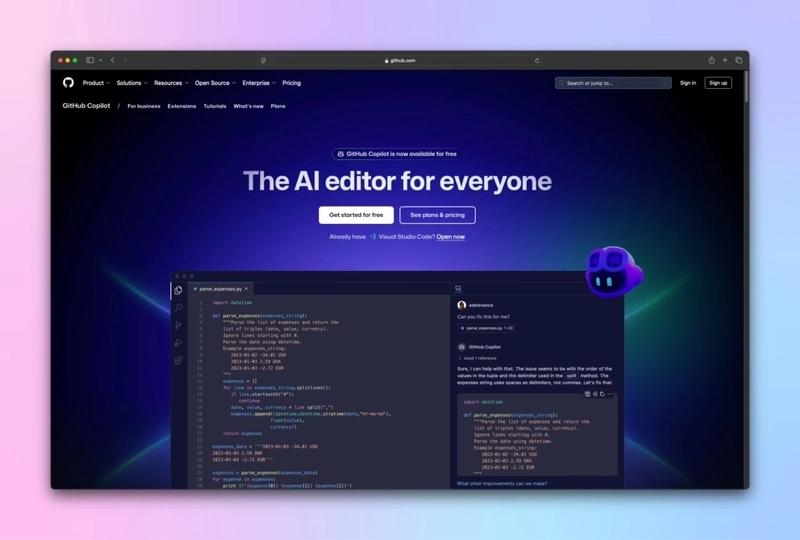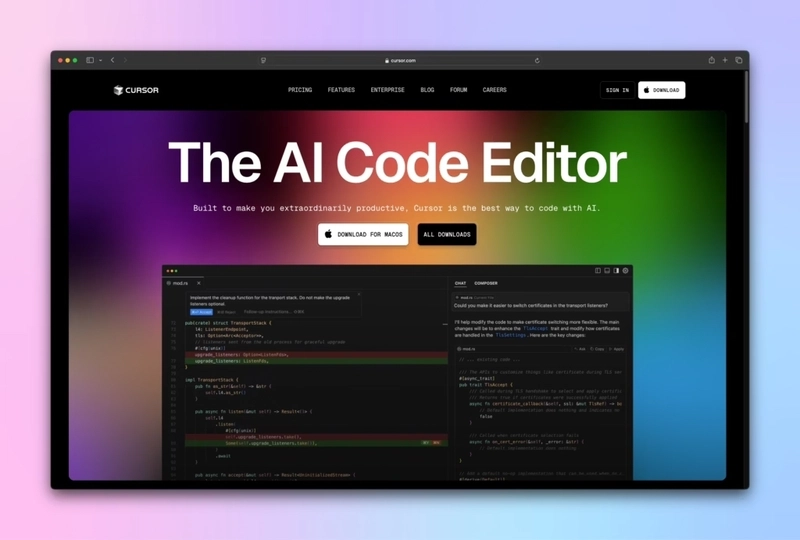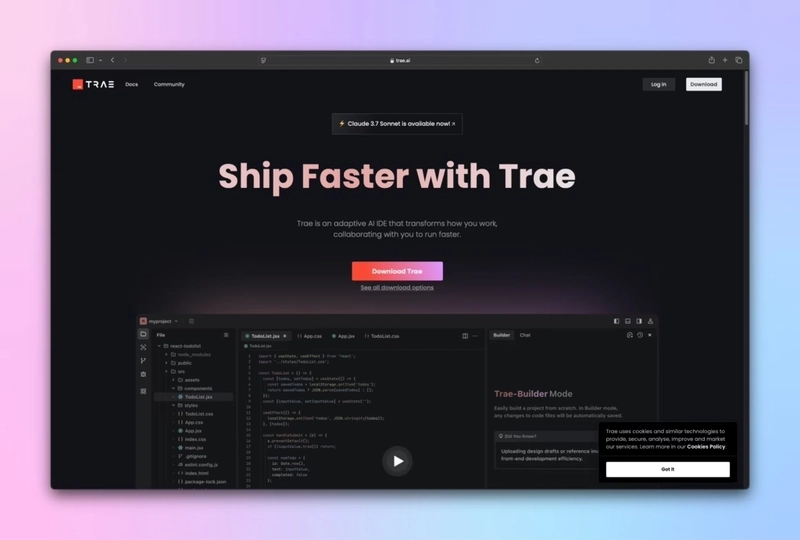Vibe Coding: Transforming Software Development Forever
The tech world is buzzing with a revolutionary concept that’s changing the way software is developed — Vibe Coding. Popularized by Andrej Karpathy in early 2025, vibe coding leverages AI-driven tools to generate code based on natural language descriptions provided by users. This paradigm shift opens doors for faster development, broader accessibility, and heightened creativity while challenging traditional programming methods. This blog delves into the fundamentals of vibe coding, explores its advantages and challenges, highlights cutting-edge Intelligent Development Environments (IDEs) such as GitHub Copilot, Cursor, and Trae.ai, and addresses its future potential. What is Vibe Coding? Vibe Coding is a transformative programming technique that utilizes large language models (LLMs) to convert human-readable prompts into executable code. Instead of painstakingly writing each line yourself, you simply describe the functionality you need, and the AI generates the code in seconds. Key Features: Origin: It was coined by Andrej Karpathy, one of AI’s leading figures, marking a pivotal moment in AI-driven software development. How It Works: Developers input casual or technical descriptions, such as “create a chatbot API,” and AI tools handle the coding process — from backend structures to executable outputs. User Focus: The focus shifts from syntax mastery to creative ideation, enabling users to concentrate on “what to build” rather than “how to code.” Benefits of Vibe Coding Speed and Efficiency: With vibe coding, developers can bypass repetitive tasks and rapidly build prototypes. What once took weeks or months can now be achieved in hours, making it ideal for startup projects and rapid iterations. Accessibility for All Users: Vibe coding democratizes software creation — individuals without coding expertise can craft applications by describing their ideas. Small businesses, designers, and entrepreneurs have found this game-changing. Enhanced Creativity: AI tools free developers from manual syntax-related tasks, allowing them to focus on larger concepts and innovative problem-solving. Vibe coding enables exploratory workflows that foster creativity across industries. Cost Savings: From freelancers to Fortune 500 companies, vibe coding minimizes dependence on large teams, reducing costs for development projects. Challenges in Vibe Coding Code Quality and Maintainability: AI-generated code is functional but not always optimized. Without proper reviews, issues like unreadable code structures or technical debt can accumulate. Developers must balance speed with maintainability. Cybersecurity Risks: AI tools might inadvertently introduce vulnerabilities like exposed API keys or poor encryption methods. Vigilance and manual audits are essential to ensure security compliance. Over-Reliance on AI Tools: Complete dependency on vibe coding tools can hinder developers’ ability to debug issues or create highly customized solutions. Developers must remain actively involved in the process. Ethical Concerns: Automation raises industry-wide questions about bias in AI, intellectual property, and job displacement for human programmers. Also, Read about Automating RAG Pipelines with Bash. https://kextcache.com/automate-rag-pipelines-with-bash-scripts/ IDEs Driving the Vibe Coding Revolution Cutting-edge Intelligent Development Environments (IDEs) are powering vibe coding, offering features that make AI-assisted programming seamless and efficient. Let’s dive into three standout IDEs: 1. GitHub Copilot GitHub Copilot, powered by OpenAI Codex, acts as an AI pair programmer. It suggests code snippets, automates repetitive tasks, and integrates smoothly with IDEs such as VS Code. Features: Multi-language support for diverse programming needs. Context-aware code suggestions tailored to project specifics. Ability to generate complex functions based on single-line comments. Example: Developers can type // Build a function that checks user input validity and Copilot instantly produces a tailored function. 2. Cursor Cursor is an IDE designed for interactive programming, enabling conversational coding and debugging. Features: Allows developers to ask questions like “What’s wrong with this function?” directly in the IDE. Supports collaborative real-time coding for team projects. Tailored for vibe coding workflows focused on iterative improvements. Example: Developers can refine SQL queries or API endpoints by asking Cursor for optimizations. 3. Trae.ai Trae.ai is redefining vibe coding with free access to pro-tier models like Claude 3.7 and DeepSeek R1, making it easier for individuals and teams to harness advanced AI for development without incurring costs. Features: Converts natural language descriptions into secure, production-ready code. Provides pre-built modules for common functionalities like authentication or payment systems

The tech world is buzzing with a revolutionary concept that’s changing the way software is developed — Vibe Coding. Popularized by Andrej Karpathy in early 2025, vibe coding leverages AI-driven tools to generate code based on natural language descriptions provided by users.
This paradigm shift opens doors for faster development, broader accessibility, and heightened creativity while challenging traditional programming methods. This blog delves into the fundamentals of vibe coding, explores its advantages and challenges, highlights cutting-edge Intelligent Development Environments (IDEs) such as GitHub Copilot, Cursor, and Trae.ai, and addresses its future potential.
What is Vibe Coding?
Vibe Coding is a transformative programming technique that utilizes large language models (LLMs) to convert human-readable prompts into executable code. Instead of painstakingly writing each line yourself, you simply describe the functionality you need, and the AI generates the code in seconds.
Key Features:
Origin: It was coined by Andrej Karpathy, one of AI’s leading figures, marking a pivotal moment in AI-driven software development.
How It Works: Developers input casual or technical descriptions, such as “create a chatbot API,” and AI tools handle the coding process — from backend structures to executable outputs.
User Focus: The focus shifts from syntax mastery to creative ideation, enabling users to concentrate on “what to build” rather than “how to code.”
Benefits of Vibe Coding
Speed and Efficiency: With vibe coding, developers can bypass repetitive tasks and rapidly build prototypes. What once took weeks or months can now be achieved in hours, making it ideal for startup projects and rapid iterations.
Accessibility for All Users: Vibe coding democratizes software creation — individuals without coding expertise can craft applications by describing their ideas. Small businesses, designers, and entrepreneurs have found this game-changing.
Enhanced Creativity: AI tools free developers from manual syntax-related tasks, allowing them to focus on larger concepts and innovative problem-solving. Vibe coding enables exploratory workflows that foster creativity across industries.
Cost Savings: From freelancers to Fortune 500 companies, vibe coding minimizes dependence on large teams, reducing costs for development projects.
Challenges in Vibe Coding
Code Quality and Maintainability: AI-generated code is functional but not always optimized. Without proper reviews, issues like unreadable code structures or technical debt can accumulate. Developers must balance speed with maintainability.
Cybersecurity Risks: AI tools might inadvertently introduce vulnerabilities like exposed API keys or poor encryption methods. Vigilance and manual audits are essential to ensure security compliance.
Over-Reliance on AI Tools: Complete dependency on vibe coding tools can hinder developers’ ability to debug issues or create highly customized solutions. Developers must remain actively involved in the process.
Ethical Concerns: Automation raises industry-wide questions about bias in AI, intellectual property, and job displacement for human programmers.
Also, Read about Automating RAG Pipelines with Bash.
https://kextcache.com/automate-rag-pipelines-with-bash-scripts/
IDEs Driving the Vibe Coding Revolution
Cutting-edge Intelligent Development Environments (IDEs) are powering vibe coding, offering features that make AI-assisted programming seamless and efficient. Let’s dive into three standout IDEs:
1. GitHub Copilot

GitHub Copilot, powered by OpenAI Codex, acts as an AI pair programmer. It suggests code snippets, automates repetitive tasks, and integrates smoothly with IDEs such as VS Code.
Features:
Multi-language support for diverse programming needs.
Context-aware code suggestions tailored to project specifics.
Ability to generate complex functions based on single-line comments.
Example: Developers can type
// Build a function that checks user input validity
and Copilot instantly produces a tailored function.
2. Cursor

Cursor is an IDE designed for interactive programming, enabling conversational coding and debugging.
Features:
Allows developers to ask questions like “What’s wrong with this function?” directly in the IDE.
Supports collaborative real-time coding for team projects.
Tailored for vibe coding workflows focused on iterative improvements.
Example: Developers can refine SQL queries or API endpoints by asking Cursor for optimizations.
3. Trae.ai

Trae.ai is redefining vibe coding with free access to pro-tier models like Claude 3.7 and DeepSeek R1, making it easier for individuals and teams to harness advanced AI for development without incurring costs.
Features:
Converts natural language descriptions into secure, production-ready code.
Provides pre-built modules for common functionalities like authentication or payment systems.
Tracks code performance and scores maintainability, enhancing project longevity.
Why Trae.ai Stands Out:
Trae.ai is currently free to use, granting users access to high-performance AI models like Claude 3.7 and DeepSeek R1 — ideal for startups or those experimenting with vibe coding.
Example: A prompt like “Build a customer support chatbot using NLP”, when fed into Trae.ai, yields a functional chatbot API that’s ready for deployment.
Also read, How Self-Hosting LLM’s can save you thousand of $$$
https://kextcache.com/self-hosting-llms-privacy-cost-efficiency-guide/
Real-World Applications of Vibe Coding
Startups and Innovation: Vibe coding is fueling rapid prototyping, enabling startups to test MVPs (Minimum Viable Products) swiftly and cost-effectively.
E-Commerce Automation: From inventory tracking to payment gateways, vibe coding simplifies backend processes for e-commerce platforms, enhancing efficiency.
Healthcare Tools: Healthcare organizations are using vibe coding to develop diagnostic applications, telemedicine systems, and patient management platforms.
Gaming and Creative Design: Gaming companies employ vibe coding for procedural level design, character scripting, and interactive storytelling based on user prompts.
Also Read, Top Uncensored Models of 2025,
https://kextcache.com/uncensored-ai-models/
The Future of Vibe Coding
What lies ahead for vibe coding?
Advanced AI Models: With the arrival of more sophisticated LLMs, vibe coding tools will generate cleaner, smarter, and more secure code, reducing manual oversight.
Citizen Developers: Vibe coding will empower non-tech users to create apps, fostering innovation across industries like education, fashion, and entertainment.
Cross-Industry Expansion: Industries from architecture to media will adopt vibe coding to streamline technical workflows.
Integration with Low-Code Platforms: Vibe coding tools will merge with low-code/no-code platforms, offering users the flexibility to make manual adjustments to AI-generated code.












































































































































































![[The AI Show Episode 142]: ChatGPT’s New Image Generator, Studio Ghibli Craze and Backlash, Gemini 2.5, OpenAI Academy, 4o Updates, Vibe Marketing & xAI Acquires X](https://www.marketingaiinstitute.com/hubfs/ep%20142%20cover.png)



























































































































![[DEALS] The Premium Learn to Code Certification Bundle (97% off) & Other Deals Up To 98% Off – Offers End Soon!](https://www.javacodegeeks.com/wp-content/uploads/2012/12/jcg-logo.jpg)


![From drop-out to software architect with Jason Lengstorf [Podcast #167]](https://cdn.hashnode.com/res/hashnode/image/upload/v1743796461357/f3d19cd7-e6f5-4d7c-8bfc-eb974bc8da68.png?#)








































































































.png?#)

































_Christophe_Coat_Alamy.jpg?#)
 (1).webp?#)





































































































![Apple Considers Delaying Smart Home Hub Until 2026 [Gurman]](https://www.iclarified.com/images/news/96946/96946/96946-640.jpg)
![iPhone 17 Pro Won't Feature Two-Toned Back [Gurman]](https://www.iclarified.com/images/news/96944/96944/96944-640.jpg)
![Tariffs Threaten Apple's $999 iPhone Price Point in the U.S. [Gurman]](https://www.iclarified.com/images/news/96943/96943/96943-640.jpg)




































































































































